- 1. ClickUp PRD Template
- 2. ClickUp Product Requirements Template
- 3. ClickUp Business Requirements Document Template
- 4. ClickUp Project Management Requirements Template
- 5. ClickUp Systems Requirements Template
- 6. ClickUp Report Requirements Template
- 7. ClickUp Product Brief Document Template
- 8. ClickUp Product Features Matrix Template
- 9. ClickUp Product Launch Checklist Template
- 10. ClickUp Product Strategy Template
- 11. Microsoft Word Product Requirements Document Template by SampleTemplates
- 12. Google Docs PRD Template
- How do I format a PRD?
- What are the benefits of using a PRD?
- What are the challenges of using a PRD?
- What should i include in a PRD?
- What are best practices for agile teams using a product requirements document?
- How can a development team use a product requirements document?
Summarize this article with AI ClickUp Brain not only saves you precious time by instantly summarizing articles, it also leverages AI to connect your tasks, docs, people, and more, streamlining your workflow like never before. Summarize article
Summarize this article for me pleaseWhat is a PRD Template?

A product requirements document (PRD), is a high-level document that encompasses everything your team members need to know about a product. It’s both a living document—a document that gets updated when product requirements change—and a single source of truth (SSOT)—a resource that everyone involved in the product can turn to for guidance. Unlike product roadmaps or user personas, which can help to refine your product vision, a PRD outlines the functional specifications that your new product must meet. Who is it for? What purpose does it serve? And who is responsible for each component? A PRD should walk your team through the entire product development process, from the starting point to the target release date. It should also include specific milestones and success metrics or key performance indicators (KPIs) that you’ll use to determine the success of the product. But how do you put it all together in one piece? Using a PRD template ensures that your product requirements document contains all of the important information and is presented in a clear, consistent format. Plus, working from a PRD template saves you from having to create a new document from scratch every time you begin the process again.
Summarize this article with AI ClickUp Brain not only saves you precious time by instantly summarizing articles, it also leverages AI to connect your tasks, docs, people, and more, streamlining your workflow like never before. Summarize article
Summarize this article for me pleaseWhat Makes a Good PRD Template?
A good product requirements document template is one that’s easy to understand and can be updated as new features or use cases are added. A PRD with too much detail might be too rigid or hard to follow, but one without enough information can result in errors and misunderstandings. It’s all about finding the right balance. ⚖️ PRDs are often used by agile development teams, which prioritize a flexible approach to product development with multiple iterations along the way. It’s important to include criteria related to security and functionality. That way, product managers know when you’re ready to release the product as well as success metrics and KPIs. But it’s OK if you don’t have all of the details you need upfront. If you have user flow diagrams or mockups, include them; otherwise, you can leave them as open questions that you or the product managers can return to later. Finally, since your PRD is a living document, ensure that your template has version control so you can revert to an earlier version of the document if necessary.
Summarize this article with AI ClickUp Brain not only saves you precious time by instantly summarizing articles, it also leverages AI to connect your tasks, docs, people, and more, streamlining your workflow like never before. Summarize article
Summarize this article for me please12 PRD Templates to Improve Your Product Development Process
Creating an effective product requirements document will put you well on your way to creating a great product. Use one of these 12 free templates to get started.
1. ClickUp PRD Template
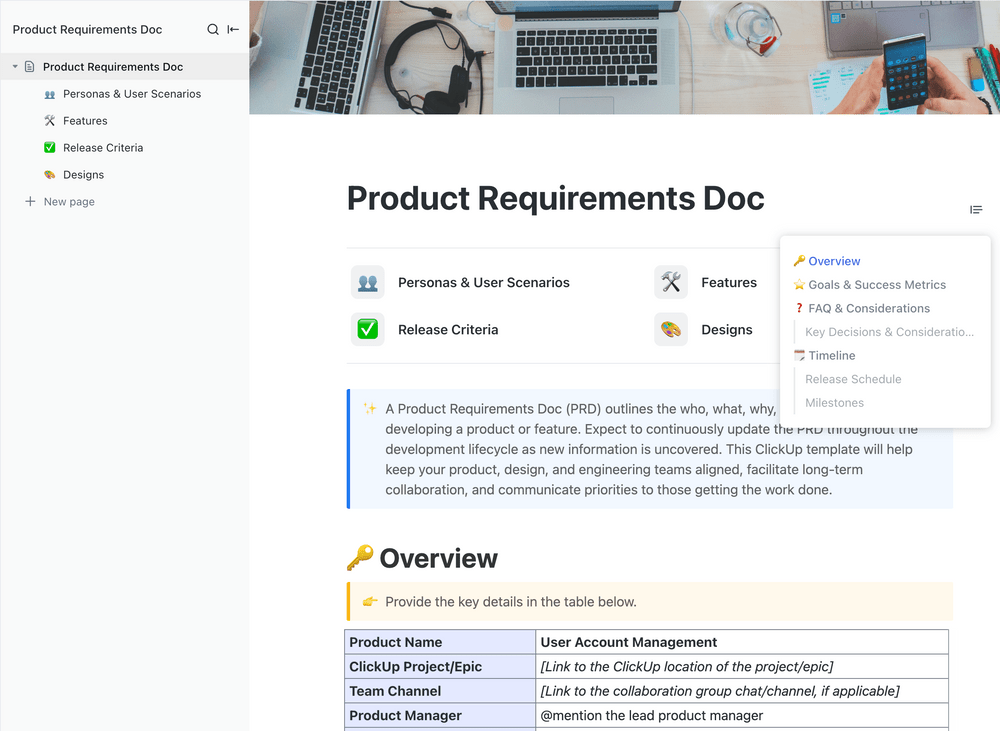
This ClickUp Product Requirements Document (PRD) Template is a beginner-friendly template that you can use to create a product requirements document even if you’ve never made one before. It has six pages covering important aspects of the product, such as Personas & User Stories, Release Criteria, and Designs. The Release Criteria page includes handy prompts such as, “What criteria must be met to validate that the product works the way it should?” One example is that “User must be able to change their subscription payment methods.” Of course, you or the product development team can reorder the pages of the template and replace the text with your own words. This helps ensure everything aligns with your development process. This template focuses on the “who, what, why, when, and how” of product development, and supports collaboration between product design and the engineering team.
2. ClickUp Product Requirements Template
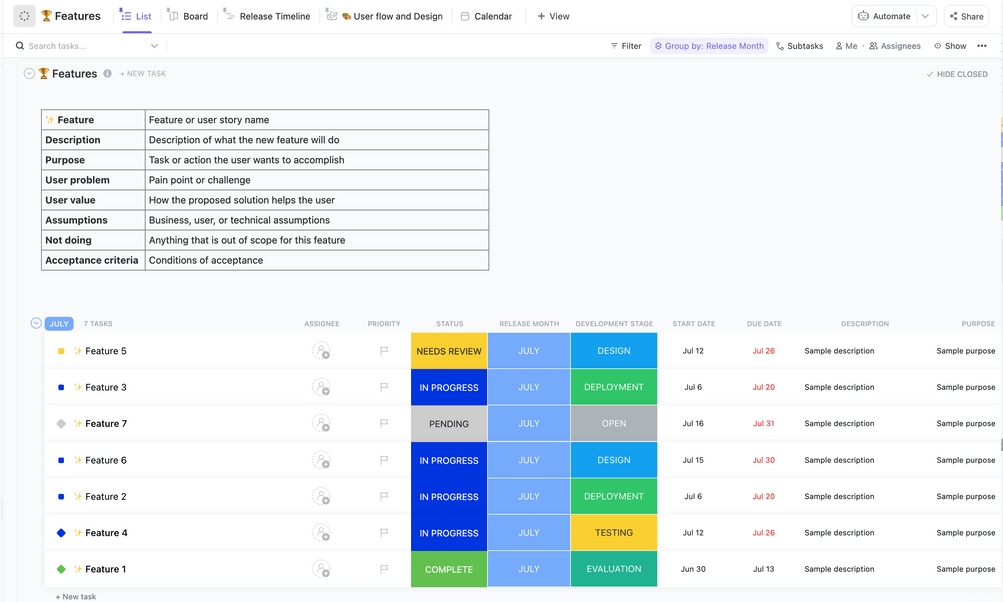
This ClickUp Product Requirements Template supports ClickUp Spaces, a cloud-based tool that lets you work collaboratively across multiple departments. This product requirements document template is great for products with multiple features since you can set a status, description, and release month for each individual feature. Create your own custom fields, switch between Board and List view types, and choose from a range of status options, from Complete to Needs Review. This PRD template works with seven ClickApps, including Time Tracking, Milestones, Priorities, and Dependency Warning. Plus, it has version control so you can keep track of your decisions and revert to an earlier version of the document if you need to. 👀 ClickUp Spaces also offers custom workflows and granular permissions control so you can specify who has access to which features.
3. ClickUp Business Requirements Document Template
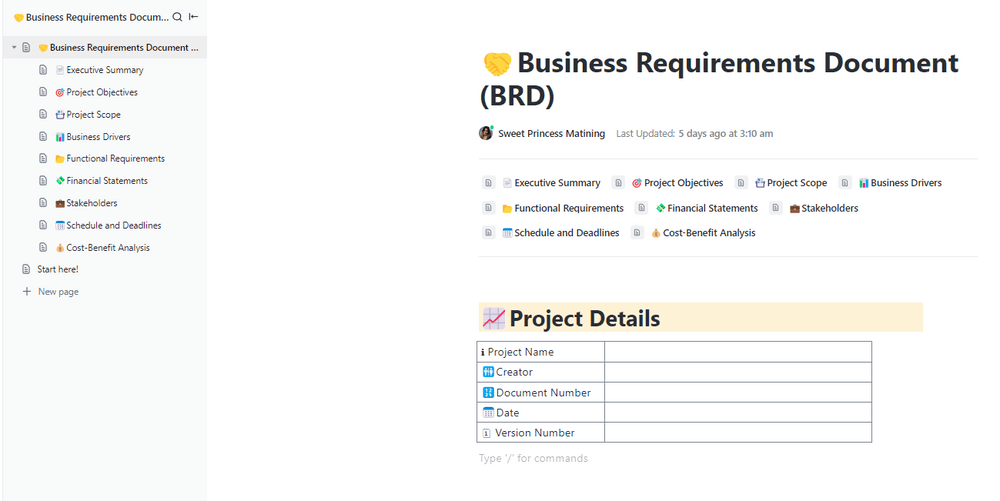 ClickUp Business Requirements Document Template" width="" height="" />
ClickUp Business Requirements Document Template" width="" height="" />
- Executive Summary
- Project Objectives
- Project Scope
- Cost-Benefit Analysis
Although it’s similar to a PRD template, its use case is slightly different as it focuses more on the needs of a business rather than the end-user. How does the product align with the overall business goals and values and what purpose does it serve?
As with other ClickUp templates, you can liven up your template with emojis, helping to break up the flow with visual cues and convey tone or brand voice across the development team. ✨
This is a beginner-friendly template so you don’t need experience writing BRDs to get started. Simply follow the outline and work through each section one by one for the ultimate development process.
4. ClickUp Project Management Requirements Template
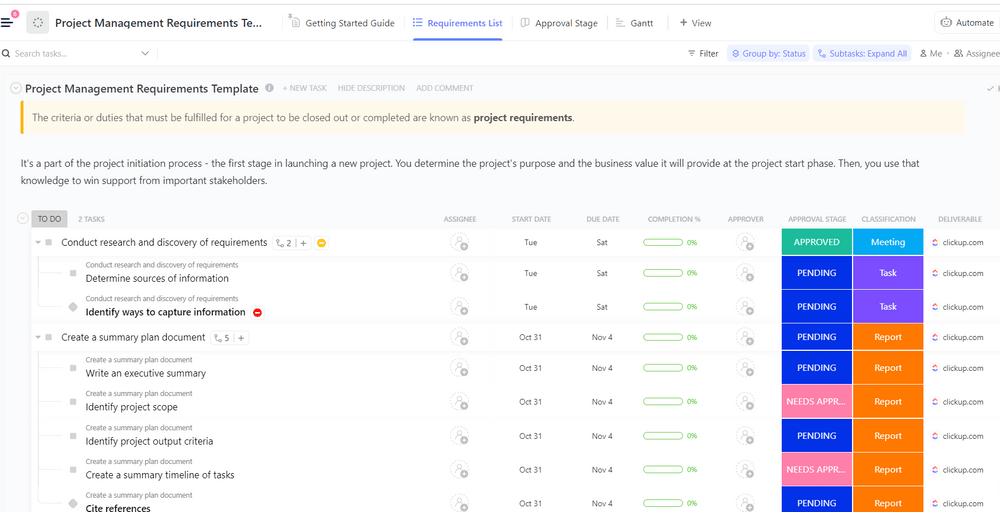
This ClickUp Project Management Requirements Template helps you create a to-do list of requirements that need to be met before a project is completed. It offers four status options in the development process, such as On Hold and In Progress, and five custom fields that you can use to show things like completion percentage and deliverables.
Each task on your to-do list can be broken down into subtasks with a start date and due date, and there are individual fields to designate an assignee and approver. You can also switch between four different view types, including a Requirements List, Gantt Chart, and Getting Started Guide.
Although you’ll still need a PRD to serve as the single source of truth for your product, using this project requirements document template can help you bridge the gap between an informative document and an actionable to-do list.
5. ClickUp Systems Requirements Template
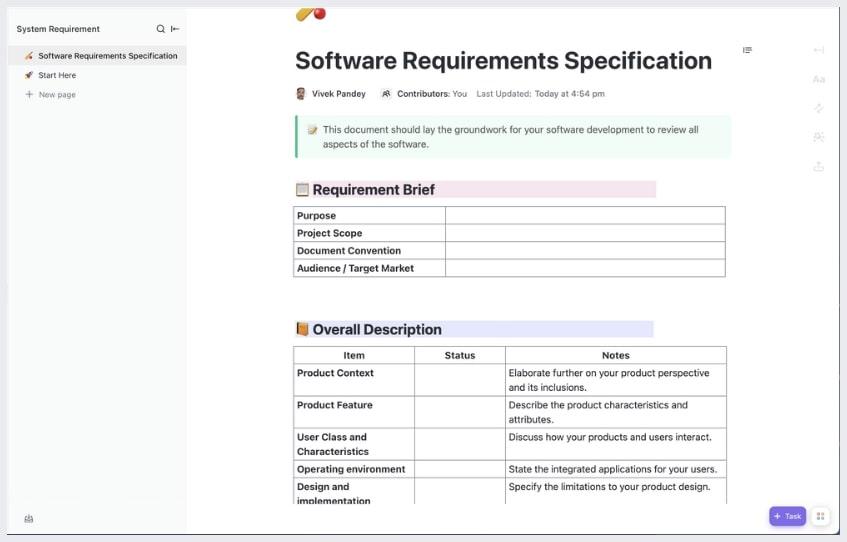
This ClickUp Systems Requirements Template is designed to help you document the software requirements of a project. At only two pages long, this product requirements document template is meant to provide a brief but concise overview of your software team’s needs.
Start by filling out the Requirement Brief with details on your purpose, project scope, and target market, then provide additional notes on the product context, design and implementation, and operating environment.
Use this free template as a standalone product management tool or as a stepping stone to a more comprehensive product requirements document for your development team.
6. ClickUp Report Requirements Template
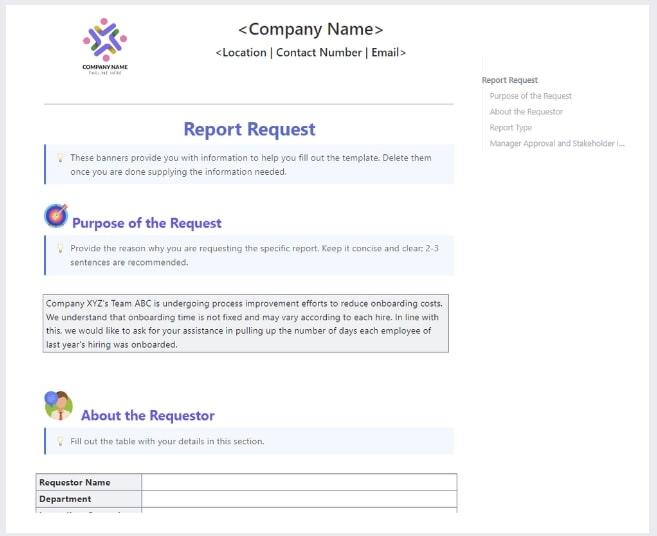
The ClickUp Report Requirements Template is designed to help you request a report from another team member by outlining all of the information you want it to include. Although not quite a product requirements document template, it serves a similar purpose by setting out clear expectations to eliminate misunderstandings.
Start by describing the purpose of the report in a few sentences, then fill in the table with the name of the requester, the department, and the report type. Once you’ve done that, update the header with your company’s name and logo, and delete the prompts so it looks clean and professional. 🤩
Using document management software to keep your PRDs and reports in one place helps your team work faster and leaves less room for error.
7. ClickUp Product Brief Document Template

This ClickUp Product Brief Document Template contains a fill-in-the-blank template to get everyone on your product team on the same page— well, pages!—of your project. You’ll start off by writing a brief explanation or summary called a 2-pager, then move on to the release plan, functional specs, and other aspects of your project.
You can embed prototypes and wireframes, weigh in with comments and feedback in the margins, and assign tasks to team members without ever leaving the document.
There’s even room for appendices. Although you can add as many pages as you want, this template should spare you from having to write the entire book. 📚
This free template is great for projects with cross-functional teams since everyone can access the same detailed information from a shared workspace in real-time.
8. ClickUp Product Features Matrix Template
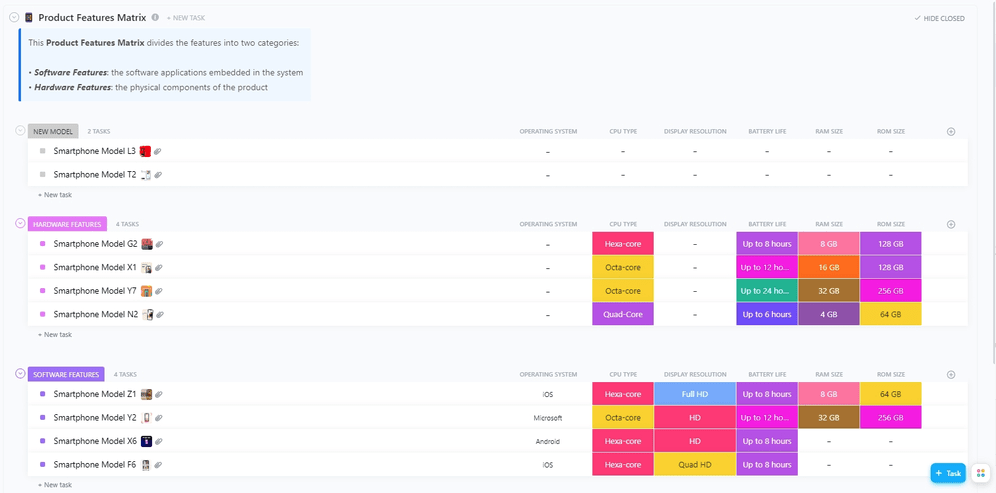
The ClickUp Product Features Matrix Template is designed to help product teams choose which product to work on next by comparing their feature requirements in a handy visual matrix.
For example, you can compare smartphone models by entering their CPU type, RAM size, and display resolution. Once you’ve entered all of the details, toggle between different view types, such as software features, hardware features, and visuals. Plus, you can use colored-coded status tags like Complete or New Model, or track progress or current status in select custom fields.
Use this template along with engineering templates to decide what to focus on next and to move from the planning stage into final product development.
9. ClickUp Product Launch Checklist Template

The ClickUp Product Launch Checklist Template is an advanced template designed to help you achieve a successful product launch. Break tasks down into categories such as Market Analysis, Pricing, and Messaging, and use the status field to mark them as Pending, Complete, or In Progress.
You can also set a start date, due date, and duration, and assign a team member to each task. Plus, mark tasks with a red or yellow flag to designate their priority.
This template allows you to switch between six view types, including a Gantt chart, timeline view, and list of activities.
Between custom fields and color-coding, this product launch checklist should include everything your product marketing team needs for a successful product release.
10. ClickUp Product Strategy Template

The ClickUp Product Strategy Template can serve as a single source of truth about your product no matter where you are in its lifecycle.
Use the status field to mark features as In Progress, On Hold, Open, or Complete, and assign each feature to a category, such as Engagement, User Growth, Content, or Usability.
Each task can have a start date, due date, and kickoff date, and be assigned to a team leader. Use the effort field to designate a task as High, Low, or Medium difficulty. Then, sort or group your list by priority, effort, active features, and other attributes.
This advanced ClickUp template offers more tools than many other templates, including automation that can set a custom field when a task is created. There’s even a built-in submission form that makes it easy for team members to suggest new features.
11. Microsoft Word Product Requirements Document Template by SampleTemplates

Just like a seasoned explorer, you’ve successfully navigated the challenges of product development so far. Now it’s time to take your expertise to the next level.
The Microsoft Word Product Requirements Document Template by SampleTemplates is the best solution for a detailed tool, ensuring you leave no stone unturned in your quest for product excellence.
This Product Requirements Document Template by SampleTemplates is a comprehensive tool that helps people understand the purpose of a product, how it works, its functional requirements, technical purpose, and scope of uses, as well as constraints, assumptions, and dependencies.
The template serves as a reference guide for product development teams, stakeholders, product developers, and designers, ensuring a clear understanding and alignment on your user stories or the desired product outcome.
12. Google Docs PRD Template

This Google Docs PRD Template is an intuitive and flexible document that is perfect for managing and collaborating on your product requirements with ease.
The template takes full advantage of Google Doc’s real-time updating, sharing, and collaborative editing features. This makes it an ideal choice for teams that operate remotely or have members spread across different locations.
Additionally, this template integrates well with other Google applications and tools, ensuring a seamless workflow. Plus, it’s available anywhere you have internet access. So, no matter where you are, your PRD is just a few clicks away.
Summarize this article with AI ClickUp Brain not only saves you precious time by instantly summarizing articles, it also leverages AI to connect your tasks, docs, people, and more, streamlining your workflow like never before. Summarize article
Summarize this article for me pleaseProduct Requirements Document FAQs
How do I format a PRD?
Formatting a PRD requires several key components. Generally, you’ll start with an introduction explaining what the product is and its purpose. Then, include sections detailing the product’s scope, the needs it addresses and its necessary features. If possible, include user stories to provide perspective and create a stronger context. Requirements should be clearly defined and divided into functional and non-functional ones. Don’t forget to include timelines, milestones, and success metrics which lay out the road map for development and the criteria for measuring success.
What are the benefits of using a PRD?
Using a PRD ensures that everyone involved in the project has a clear understanding of the product’s requirements and its goals. It aligns team members, maximizes efficiency by reducing misunderstandings, and helps to set and manage expectations. PRDs also help to hold everyone accountable as they clearly assign responsibilities and tasks. Lastly, they act as a living document that can be altered as the product evolves, thereby staying relevant throughout the development.
What are the challenges of using a PRD?
PRDs can be quite comprehensive, and it may take some time and effort to create a robust one. They can also be difficult to keep up to date, especially in a dynamic project where product goals and requirements may change frequently. Additionally, there can be challenges in maintaining flexibility and adaptability while adhering to the guidelines that a PRD provides. Also, while a PRD is intended to avoid misunderstanding, it is still possible for different interpretations of the requirements to arise, leading to possible conflicts or misalignment.
What should i include in a PRD?
A well-crafted PRD should include a clear objective or purpose of the product, target audience, product description, features and functionalities necessary to achieve the objectives, constraints, dependencies, and any assumptions that are made. Furthermore, it should include success metrics, timelines, and milestones to ensure everyone has a clear roadmap for product development.
What are best practices for agile teams using a product requirements document?
For agile teams, it’s important to maintain the flexibility of the PRD to cope with changing project dynamics and customer needs. Prioritization of features should be taken into account, focusing on user value above all else. Break down each requirement into small, manageable tasks or user stories, and involve the entire team in the creation process. This ensures understanding and buy-in from everyone. Regularly review and update the PRD as changes occur, and ensure effective communication and clear expectations are set by using the PRD as the main reference point.
How can a development team use a product requirements document?
A development team uses a PRD as a guide during the product development process. The document includes necessary details about product functionalities, user interactions, and the overall product goals. Using this shared reference, the team can align their efforts, ensure they meet the desired outcomes, track progress against milestones, and manage changes or updates efficiently. The PRD also aids in clear communication within the team and with other stakeholders, preventing misunderstandings and ensuring that everyone has a unified vision of the product.
Manage Your Product Lifecycle With ClickUp’s Product Requirement Document Templates.Summarize this article with AI ClickUp Brain not only saves you precious time by instantly summarizing articles, it also leverages AI to connect your tasks, docs, people, and more, streamlining your workflow like never before. Summarize article